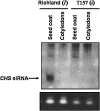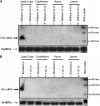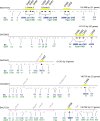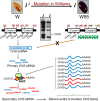Endogenous, tissue-specific short interfering RNAs silence the chalcone synthase gene family in glycine max seed coats
- PMID: 19820189
- PMCID: PMC2782299
- DOI: 10.1105/tpc.109.069856
Endogenous, tissue-specific short interfering RNAs silence the chalcone synthase gene family in glycine max seed coats
Erratum in
- Plant Cell. 2010 May;22(5):1647
Abstract
Two dominant alleles of the I locus in Glycine max silence nine chalcone synthase (CHS) genes to inhibit function of the flavonoid pathway in the seed coat. We describe here the intricacies of this naturally occurring silencing mechanism based on results from small RNA gel blots and high-throughput sequencing of small RNA populations. The two dominant alleles of the I locus encompass a 27-kb region containing two perfectly repeated and inverted clusters of three chalcone synthase genes (CHS1, CHS3, and CHS4). This structure silences the expression of all CHS genes, including CHS7 and CHS8, located on other chromosomes. The CHS short interfering RNAs (siRNAs) sequenced support a mechanism by which RNAs transcribed from the CHS inverted repeat form aberrant double-stranded RNAs that become substrates for dicer-like ribonuclease. The resulting primary siRNAs become guides that target the mRNAs of the nonlinked, highly expressed CHS7 and CHS8 genes, followed by subsequent amplification of CHS7 and CHS8 secondary siRNAs by RNA-dependent RNA polymerase. Most remarkably, this silencing mechanism occurs only in one tissue, the seed coat, as shown by the lack of CHS siRNAs in cotyledons and vegetative tissues. Thus, production of the trigger double-stranded RNA that initiates the process occurs in a specific tissue and represents an example of naturally occurring inhibition of a metabolic pathway by siRNAs in one tissue while allowing expression of the pathway and synthesis of valuable secondary metabolites in all other organs/tissues of the plant.
Figures







Similar articles
-
The transition from primary siRNAs to amplified secondary siRNAs that regulate chalcone synthase during development of Glycine max seed coats.PLoS One. 2013 Oct 21;8(10):e76954. doi: 10.1371/journal.pone.0076954. eCollection 2013. PLoS One. 2013. PMID: 24204712 Free PMC article.
-
Tissue-specific gene silencing mediated by a naturally occurring chalcone synthase gene cluster in Glycine max.Plant Cell. 2004 Apr;16(4):819-35. doi: 10.1105/tpc.021352. Plant Cell. 2004. PMID: 15064367 Free PMC article.
-
Patterning of virus-infected Glycine max seed coat is associated with suppression of endogenous silencing of chalcone synthase genes.Plant Cell. 2004 Apr;16(4):807-18. doi: 10.1105/tpc.019885. Epub 2004 Mar 22. Plant Cell. 2004. PMID: 15037735 Free PMC article.
-
Biogenesis of trans-acting siRNAs, endogenous secondary siRNAs in plants.Genes Genet Syst. 2013;88(2):77-84. doi: 10.1266/ggs.88.77. Genes Genet Syst. 2013. PMID: 23832299 Review.
-
Gene silencing in mammals by small interfering RNAs.Nat Rev Genet. 2002 Oct;3(10):737-47. doi: 10.1038/nrg908. Nat Rev Genet. 2002. PMID: 12360232 Review.
Cited by
-
Identification of ST1 reveals a selection involving hitchhiking of seed morphology and oil content during soybean domestication.Plant Biotechnol J. 2022 Jun;20(6):1110-1121. doi: 10.1111/pbi.13791. Epub 2022 Mar 5. Plant Biotechnol J. 2022. PMID: 35178867 Free PMC article.
-
Host-derived gene silencing of parasite fitness genes improves resistance to soybean cyst nematodes in stable transgenic soybean.Theor Appl Genet. 2019 Sep;132(9):2651-2662. doi: 10.1007/s00122-019-03379-0. Epub 2019 Jun 22. Theor Appl Genet. 2019. PMID: 31230117 Free PMC article.
-
Genome-Wide Identification and Comparative Analysis of the 3-Hydroxy-3-methylglutaryl Coenzyme A Reductase (HMGR) Gene Family in Gossypium.Molecules. 2018 Jan 24;23(2):193. doi: 10.3390/molecules23020193. Molecules. 2018. PMID: 29364830 Free PMC article.
-
Regulation of Isoflavone Biosynthesis by miRNAs in Two Contrasting Soybean Genotypes at Different Seed Developmental Stages.Front Plant Sci. 2017 Apr 13;8:567. doi: 10.3389/fpls.2017.00567. eCollection 2017. Front Plant Sci. 2017. PMID: 28450878 Free PMC article.
-
QTL Mapping and Transcriptome Analysis Reveal Candidate Genes Regulating Seed Color in Brassica napus.Int J Mol Sci. 2023 May 25;24(11):9262. doi: 10.3390/ijms24119262. Int J Mol Sci. 2023. PMID: 37298213 Free PMC article.
References
-
- Allen, E., Xie, Z., Gustafson, A.M., Sung, G.-H., Spatafora, J.W., and Carrington, J.C. (2004). Evolution of microRNA genes by inverted duplication of target gene sequences in Arabidopsis thaliana. Nat. Genet. 36 1282–1290. - PubMed
-
- Altschul, S.F., Gish, W., Miller, W., Myers, E.W., and Lipman, D.J. (1990). Basic local alignment search tool. J. Mol. Biol. 215 403–410. - PubMed
-
- Bartel, D.P. (2004). MicroRNAs: Genomics, biogenesis, mechanism, and function. Cell 116 281–297. - PubMed
-
- Baulcombe, D. (2004). RNA silencing in plants. Nature 431 356–363. - PubMed
Publication types
MeSH terms
Substances
Associated data
- Actions
- Actions
- Actions
- Actions
- Actions
- Actions
- Actions
LinkOut - more resources
Full Text Sources
Other Literature Sources
Molecular Biology Databases

